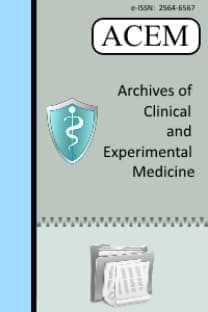Vestibüler schwanomlarda Koos sınıflaması ile ADC-post kontrast sinyal intensite değerlerinin ilişkisi – Bir kesitsel çalışma
The relationship between Koos classification and ADC-post-contrast signal intensity values of vestibular schwannoma - A cross sectional study
___
- 1. Lin D, Hegarty JL, Fischbein NJ, Jackler RK. The prevalence of "incidental" acoustic neuroma. Arch Otolaryngol Head Neck Surg. 2005;131:241-4.
- 2. Goldbrunner R, Weller M, Regis J, Lund-Johansen M, Stavrinou P, Reuss D. et al. EANO guideline on the diagnosis and treatment of vestibular schwannoma. Neuro Oncol. 2020;22:31-45.
- 3. Evans DG, Moran A, King A, Saeed S, Gurusinghe N, Ramsden R. Incidence of vestibular schwannoma and neurofibromatosis 2 in the North West of England over a 10-year period: higher incidence than previously thought. Otol Neurotol. 2005;26:93-7.
- 4. Singh K, Singh MP, Thukral C, Rao K, Singh K, Singh A. Role of magnetic resonance imaging in evaluation of cerebellopontine angle schwannomas. Indian J Otolaryngol Head Neck Surg. 2015;67:21-7. 5. De Foer B, Kenis C, Van Melkebeke D, Vercruysse JP, Somers T, Pouillon M. et al. Pathology of the vestibulocochlear nerve. Eur J Radiol. 2010;74:349-58.
- 6. Leon J, Lehrer EJ, Peterson J, Vallow L, Ruiz-Garcia H, Hadley A. et al. Observation or stereotactic radiosurgery for newly diagnosed vestibular schwannomas: A systematic review and meta-analysis. J Radiosurg SBRT. 2019;6:91-100.
- 7. Koos WT, Day JD, Matula C, Levy DI. Neurotopographic considerations in the microsurgical treatment of small acoustic neurinomas. J Neurosurg. 1998;88:506-12.
- 8. Erickson NJ, Schmalz PGR, Agee BS, Fort M, Walters BC, McGrew BM. et al. Koos Classification of Vestibular Schwannomas: A Reliability Study. Neurosurgery. 2019;85:409-414..
- 9. Rueß D, Pöhlmann L, Grau S, Hamisch C, Hoevels M, Treuer H. et al. Outcome and toxicity analysis of single dose stereotactic radiosurgery in vestibular schwannoma based on the Koos grading system. Sci Rep. 2020;10:930
- 10. Régis J, Carron R, Moucharrafien S, Delsantin C, Porcheron D, Thomassin JM. et al. Radiochirurgie et radiothérapie stéréotaxique des schwannomes vestibulaires [Role of radiosurgery and stereotactic radiotherapy in the management of vestibular schwannomas]. Cancer Radiother. 2012;16 Suppl:S70-8.
- 11. Morton RP, Ackerman PD, Pisansky MT, Krezalek M, Leonetti JP, Raffin MJ. et al. Prognostic factors for the incidence and recovery of delayed facial nerve palsy after vestibular schwannoma resection. J Neurosurg. 2011;114:375-80
- 12. Copeland W, Hoover J, Morris J, Driscoll C, Link M Use of preoperative MRI to predict vestibular schwannoma intraoperative consistency and facial nerve outcome. J Neurol Surg B Skull Base. 2013;74:347–350.
- 13. Kunigelis KE, Hosokawa P, Arnone G, Raban D, Starr A, Gurau A. et al. The predictive value of preoperative apparent diffusion coefficient (ADC) for facial nerve outcomes after vestibular schwannoma resection: clinical study. Acta Neurochir (Wien). 2020;162:1995- 2005.
- 14. Lin EP, Crane BT. The Management and Imaging of Vestibular Schwannomas. AJNR Am J Neuroradiol. 2017;38:2034-43.
- 15. Xu XQ, Li Y, Hong XN, Wu FY, Shi HB. Radiological indeterminate vestibular schwannoma and meningioma in cerebellopontine angle area: differentiating using whole-tumor histogram analysis of apparent diffusion coefficient. Int J Neurosci. 2017;127:183-90.
- 16. Huang CF, Chiou SY, Wu MF, Tu HT, Liu WS, Chuang JC. Apparent diffusion coefficients for evaluation of the response of brain tumors treated by Gamma Knife surgery. J Neurosurg. 2010;113 Suppl:97- 104.
- ISSN: 2564-6567
- Yayın Aralığı: 3
- Başlangıç: 2016
- Yayıncı: -
Ani idiopatik sensorinöral işitme kaybı olan hastalardaki yaşam kalitesinin retrospektif analizi
Mahmut Tayyar KALCIOĞLU, Ahmet MUTLU, Ayşe Yasemin GÜNDÜZ, Fatih BİLGİN, Burcu BAKICI BALCI, Emre KORKMAZ, Abdullah Emre AKSUN, Halit GÜREL, Mehmet Zahit MENGİ, Yusuf DOĞRUYOL
Müjdat UYSAL, Işın DOĞAN EKİCİ, İlknur BİNGÜL, Canan KÜÇÜKGERGİN, A. Fatih AYDIN, Semra DOĞRU ABBASOĞLU
Bir COVID-19 hastasında sialadenit ve tiroiditin atipik birlikteliği: Bir olgu sunumu
Deniz İNCAMAN, Gamze Gül GÜLEÇ
Mevlüt Recep PEKCİCİ, Marlen SÜLEYMAN, Koray KOŞMAZ, Mehmet ŞENES, Özlem TANAS IŞIKÇI, Abdullah ŞENLİKÇİ, İknur ALKAN KUSABBİ, Yılmaz ÜNAL, Yusuf Murat BAĞ, Sema HÜCÜMENOĞLU
Mehmet AZİRET, Enis DİKİCİER, Emrah AKIN, Fatih ALTINTOPRAK, Barış MANTOĞLU, Necattin FIRAT, Hakan DEMİR, Tarık HARMATEPE, Recayi ÇAPOĞLU
Nesrin GÜNDÜZ, Başak ATALAY, Umut Perçem Orhan SÖYLEMEZ
Refraktif akomodatif ezotropya hastalarında stereopsis düzeyi ve ilişkili faktörler
Tavşanlarda Spinal Lomber Füzyon için Otogreft ve DBM Flex'in (Grafton) Deneysel Karşılaştırması
Cem DEMİREL, Dursun TÜRKÖZ, Tuncay YİLMAZ
